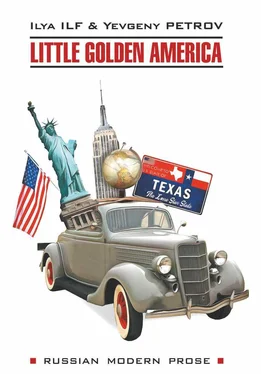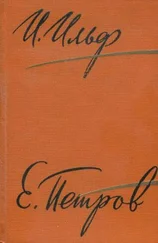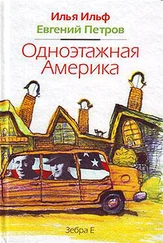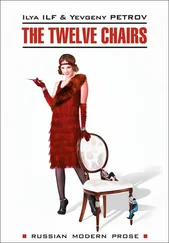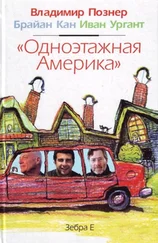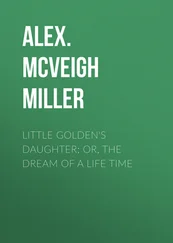Under the sooty spans of a bridge, in the shadow of which gleamed mud left over from last night’s rain, a man with hat aslant and an open shirt was delivering a speech. About a score of the curious gathered around him. He was a propagandist for the ideas of the recently assassinated United States senator from Louisiana, Huey P. Long. He spoke on distribution of wealth. His listeners asked him questions. He replied. His chief task seemed to be to amuse his audience. Not far from him, on the sunflecked sidewalk stopped a fat Negress of the Salvation Army. She wore an old-fashioned bonnet and run-down shoes. She took a bell out of her suitcase and rang it loudly. The suitcase she placed on the sidewalk at her feet. After waiting for a few disciples of the late-lamented senator to desert to her side, squinting against the sun, she began to bellow something, rolling her eyes and banging her own fat bosom. We went several blocks, but the shouting of the Negress was still distinctly heard in the component noise of this restless city.
In front of a ready-to-wear store a man walked calmly back and forth. On his back and on his chest he carried two identical placards: “This Place Is On Strike”. In the next street were a few more pickets. Over the large show window of a corner store, despite the sunny morning, gleamed the blue letters “Cafeteria” in electric lights. The cafeteria was large, bright, and clean. Along the walls were glass cases filled with beautiful, appetizing edibles. To the left of the entrance was the cashier’s booth. Onhe right was a metal stand with small slot athwart as in a coin bank. From the opening emerged the end of a blue pasteboard stub. Those who entered tugged at this end. We also tugged. The melodic clang of a bell resounded. One stub was in our hand, and through the slot of the coin bank another blue stub popped out. Then we did what all New Yorkers do when they dash into a cafeteria for a hurried bite. From a special table we each took a light brown tray, placed on it forks, spoons, knives, and paper napkins; and, feeling extremely awkward in our heavy overcoats and hats, went to the right end of a glass-enclosed counter. Down the entire length of this counter ran three rows of nickelled pipes on which we conveniently placed our trays and slid them along after placing each dish upon them. The counter itself was a tremendous camouflaged electric plate. Soups, chunks of roast, sausages of various lengths and thicknesses, legs of pork and lamb, meat loaves and roulades, mashed, fried, baked, and boiled potatoes and potatoes curiously shaped in pellets, globules of Brussels sprouts, spinach, carrots, and numerous other side dishes were kept warm here. White chefs in starched nightcaps, aided by neat but heavily rouged and marcelled girls in pink headdresses, were busy placing on the glass cover of the counter plates of food and punching that figure on the stub which indicated the cost of each dish. Then came salads and vinaigrettes, various hors d’oeuvres, fish in cream sauces and fish in jellied sauces. Then came bread, rolls, and traditional round pies with apple, strawberry, and pineapple fillings. Here coffee and milk were issued. We moved down the counter, pushing our trays. On the thick layer of chipped ice were plates of compotes and ice-cream, oranges and grapefruit cut in half, large and small glasses with various juices. Persistent advertising has taught Americans to drink juices before break-fast and lunch. In the juices are vitamins which are presumably beneficial to the customers, while the sale of juices is indubitably of benefit to fruit merchants. We soon succumbed to this American custom. At first we drank the thick yellow orange juice. Then we passed to the translucent green juice of the grapefruit. Then before eating we began to take the grapefruit itself (it is covered with sugar and is eaten with a spoon; its taste reminds one somewhat of the taste of an orange with a dash of lemon in it, although it is juicier than both these fruits). Finally, with some trepidation and not all at once, we began to imbibe the mundane tomato juice, peppering it a bit beforehand. That proved to be the tastiest of all and the most refreshing, and it best suited our South Russian stomachs. The one thing we did not learn to do in America was to eat melon before dinner. Yet that takes the place of honour among American hors d’oeuvres.
In the middle of the cafeteria stood polished wooden tables without tablecloths, and beside them coat-racks. Those who wished could put their hats under their chairs, where there was a special shelf for that purpose. On the tables were stands with bottles of oil, vinegar, catsup, and various other condiments. There was also granulated sugar in a glass flagon wrought in the manner of a pepper-shaker with holes in its metal stopper.
The settling of accounts with the customers was simple. No one could leave the cafeteria without sooner or later passing the cashier’s booth and presenting the stub with the total punched in it. Here also cigarettes were sold and one was free to take a toothpick.
The process of eating was just as superbly rationalized as the production of automobiles or of typewriters.
The automats have progressed farther along this road than the cafeterias. Although they have approximately the same outward appearance as the cafeterias, they differ from the latter in that they have carried the process of pushing food into American stomachs to the point of virtuosity. The walls of the automats are occupied throughout with little glass closets. Near each one of them is a slit for dropping a “nickel” (a five-cent coin). Behind the glass stands a dour sandwich or a glass of juice or a piece of pie. Despite the shining glass and metal, the sausages and cutlets deprived of liberty somehow produce a strange impression. One pities them, like cats at a show. A man drops a nickel, acquires the right to open the little door, takes out his sandwich, carries it to his table and there eats it, again putting his hat under his chair on the special shelf. Then the man goes up to a tap, drops his “nickel,” and out of the tap into the glass drips exactly as much coffee and milk as is supposed to drip. One feels something humiliating, something insulting to man in that. One begins to suspect that the owner of the automat has outfitted his establishment, not in order to present society with a pleasant surprise, but in order to discharge from service poor marcelled girls with pink headdresses and thereby earn a few more dollars.
But automats are not over popular in America. Evidently the bosses themselves feel that there must be some limit to rationalization. Hence, the normal little restaurants, for people of modest means, belonging to mighty trusts are always full. The most popular of these – Childs – has become in America a standard for inexpensive food of good quality. “He dines at Childs”: that means that the man earns $30 a week. In any part of New York one can say: “Let’s have dinner at Childs,” and it would not take him more than ten minutes to reach Childs. At Childs one receives the same clean handsome food as in a cafeteria or an automat. Only there one is not deprived of the small satisfaction of looking at a menu, saying “H’m,” asking the waitress whether the veal is good, and receiving the answer: “Yes, sir!”
Generally speaking, New York is remarkable because it has everything. There you can find the representatives of any nation, secure any dish, any object from an embroidered Ukrainian shirt to a Chinese stick with a bone handle in the shape of a hand, which is used for back-scratching, from Russian caviare and vodka to Chilean soup and Italian macaroni. There are no delicacies in the world that New York cannot offer. But for all of it one must pay in dollars. And we want to talk about the preponderant majority of Americans who can pay only cents and for whom exist Childs, cafeterias, and automats. When describing the latter establishments, we can boldly declare that this is how the average American is fed. Under this concept of the average American is presupposed a man who has a decent job and a decent salary and who from the point of view of capitalism is an example of the healthy prospering American, happy and optimistic, who receives all the blessings of life at a comparatively low price.
Читать дальше
